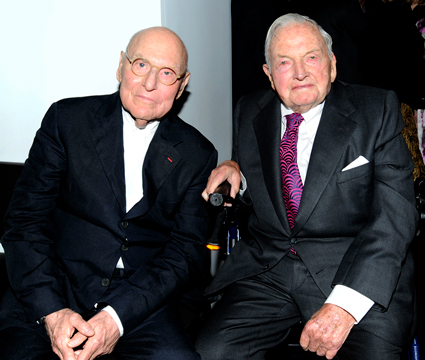David Rockefeller, a philanthropist who donated significant works to the Museum of Modern Art and who, in his years as chairman and then honorary chairman of its board, dramatically enlarged the museum’s endowment, died this morning at his home in Poncatino Hills, New York. He was 101.
Much of Rockefeller’s art-world legacy has been cemented by his contributions to MoMA. He first served on the New York museum’s board starting as chairman starting in 1948, and would go on to do two more terms in that position. He was later named honorary chairman, a status he held until today.
With a fortune amassed by way of inheritance and work as a prominent banker at Chase Manhattan Bank, Rockefeller used his social cachet to bring in money from collectors and celebrities—although he, too, was instrumental in enlarging the museum’s endowment. In 2005, he donated $100 million—a historic bequest that went toward the museum’s educational programs. He also contributed $77 million toward MoMA’s $858 renovation plan.
Rockefeller also had a taste for collecting and was known to buy works by modernist masters. In his collection were paintings, drawings, and prints by Paul Cézanne, André Derain, Willem de Kooning, Paul Gauguin, Henri Matisse, Georgia O’Keeffe, and Pablo Picasso, among many others. His collection included a number of masterpieces. When he sold a 1950 Mark Rothko painting from his collection at Sotheby’s in 2007, it went to Sheikh Hamad bin Khalifa Al-Thani and Mozah bint Nasser Al Missned for $72.8 million—a record at the time for a postwar work sold at auction.
Some of his works have been given to MoMA as “fractional gifts,” or donations that include artworks added to the museum’s collection over time, for tax-related reasons. In 1994, the collection of Rockefeller and his wife, Peggy, was the subject of a MoMA exhibition.

He was known to be a cautious collector. “I’m not actively collecting, unless I see something irresistible,” he told ARTnews in 2005. Nevertheless, Rockefeller was on this magazine’s annual Top 200 Collectors list ten times, appearing every year from 1996 through 2005.
David Rockefeller was born in 1915 in New York City. He was exposed to art from a young age by his mother, Abby Aldrich Rockefeller, a collector herself. Abby, who was one of MoMA’s founders, amassed a significant grouping of Asian and modernist artworks. (David later gave Abby’s Asian art collection to the Asia Society in New York.) His father, John D. Rockefeller, Jr., disliked modern art. In interviews, David often discussed being taken under the wing of Alfred H. Barr, Jr., MoMA’s first director, who put him in touch with such artists as Matisse and Marc Chagall.
By his own admission, Rockefeller was skeptical when it came to contemporary art. He talked about being bewildered by the rise of video art, the embrace of street art as a movement, and critical love for photography that he deemed “perverse.” “When I return to the comforting confines of my home and its Cézannes, Signacs, and Derains glowing peaceably around me, I feel relieved,” he told The Art Newspaper in 2003. “But I remember that these men were once members of a revolutionary vanguard themselves, and their work was ridiculed as grotesque, pointless, and without beauty. They invented ‘modern art’ and changed the way the world was perceived. Perhaps the present generation of ‘modern’ artists has more to offer than I am giving them credit for.”








